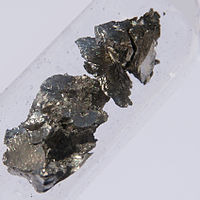
Photo from wikipedia
Abstract Praseodymium (Pr3+) and Erbium (Er3+) doped zinc phosphate glasses with chemical compositions (60 − x) NH4H2PO4 + 20ZnO + 10BaF2 + 10NaF + xRE (where RE = Pr6O11 and Er2O3, x = 0.1, 0.5, 1.0, 1.5 and 2.0 mol%) have been prepared by melt… Click to show full abstract
Abstract Praseodymium (Pr3+) and Erbium (Er3+) doped zinc phosphate glasses with chemical compositions (60 − x) NH4H2PO4 + 20ZnO + 10BaF2 + 10NaF + xRE (where RE = Pr6O11 and Er2O3, x = 0.1, 0.5, 1.0, 1.5 and 2.0 mol%) have been prepared by melt quenching technique. Amorphous structure was ascertained by XRD analysis. The functional and vibrational bands have been assigned and clearly elucidated by FT-IR and Raman spectral profiles for all the glass samples. Judd–Ofelt (J–O) intensity parameters (Ωλ: λ = 2, 4, 6) have been obtained from the spectral intensities of different absorption bands of Pr3+ and Er3+ ions through optical absorption spectra. The radiative properties such as radiative transition probabilities (AR), radiative lifetimes (τR) and branching ratios (βR) for different excited states were calculated by using J–O intensity parameters. Visible photoluminescence spectra have exhibited six emission bands (3P1 → 3H5, 1D2 → 3H4, 3P0 → 3F2, 3P1 → 3F3, 3P0 → 3F3 and 3P0 → 3F4 states) for all the concentrations of Pr3+ ions. NIR photoluminescence spectra exhibited one emission band (4I15/2 → 4I13/2) of Er3+ ions. The energy transfer mechanism that leads to the quenching of lifetimes of 1D2 and 4I13/2 states have been discussed at higher concentrations of Pr3+ and Er3+ ions, respectively. These glasses were suggested as suitable hosts to produce intense orange emission at 608 nm for Pr3+ ion and efficient lasing action in NIR region at 1534 nm for Er3+ ion.
Journal Title: Indian Journal of Physics
Year Published: 2017
Link to full text (if available)
Share on Social Media: Sign Up to like & get
recommendations!